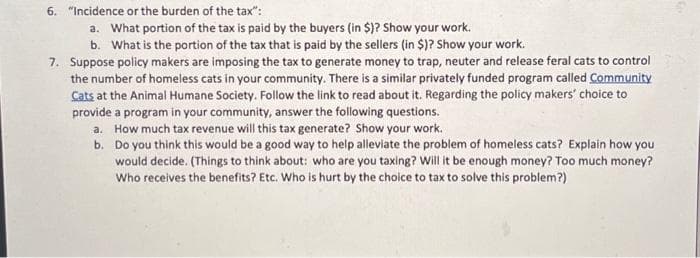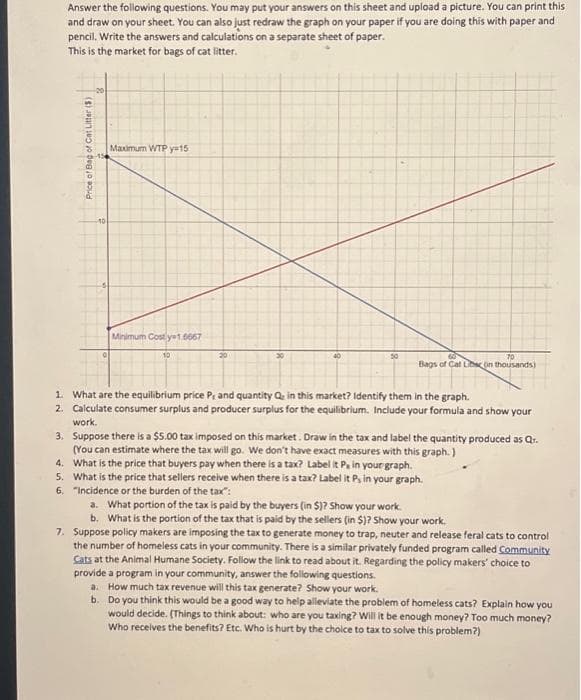"Incidence or the burden of the tax": a. What portion of the tax is paid by the buyers (in $)? Show your work. b. What is the portion of the tax that is paid by the sellers (in $)? Show your work.
"Incidence or the burden of the tax": a. What portion of the tax is paid by the buyers (in $)? Show your work. b. What is the portion of the tax that is paid by the sellers (in $)? Show your work.
Chapter6: Demand Relationships Among Goods
Section: Chapter Questions
Problem 6.4P
Related questions
Question
=>Please solve only 6 and 7 i give good feedback please fast.

Transcribed Image Text:6. "Incidence or the burden of the tax":
a. What portion of the tax is paid by the buyers (in $)? Show your work.
b. What is the portion of the tax that is paid by the sellers (in $)? Show your work.
7. Suppose policy makers are imposing the tax to generate money to trap, neuter and release feral cats to control
the number of homeless cats in your community. There is a similar privately funded program called Community
Cats at the Animal Humane Society. Follow the link to read about it. Regarding the policy makers' choice to
provide a program in your community, answer the following questions.
a. How much tax revenue will this tax generate? Show your work.
b.
Do you think this would be a good way to help alleviate the problem of homeless cats? Explain how you
would decide. (Things to think about: who are you taxing? Will it be enough money? Too much money?
Who receives the benefits? Etc. Who is hurt by the choice to tax to solve this problem?)

Transcribed Image Text:Answer the following questions. You may put your answers on this sheet and upload a picture. You can print this
and draw on your sheet. You can also just redraw the graph on your paper if you are doing this with paper and
pencil. Write the answers and calculations on a separate sheet of paper.
This is the market for bags of cat litter.
Price of Bag of Cat Litter (5)
10
Maximum WTP y=15
Minimum Costly 1.6667
10
20
50
70
Bags of Cat Libec (in thousands)
1. What are the equilibrium price P, and quantity Q, in this market? Identify them in the graph.
2. Calculate consumer surplus and producer surplus for the equilibrium. Include your formula and show your
work.
3. Suppose there is a $5.00 tax imposed on this market. Draw in the tax and label the quantity produced as Qr.
(You can estimate where the tax will go. We don't have exact measures with this graph.)
4. What is the price that buyers pay when there is a tax? Label it P, in your graph.
5. What is the price that sellers receive when there is a tax? Label it Ps in your graph.
6. "Incidence or the burden of the tax":
a. What portion of the tax is paid by the buyers (in $)? Show your work.
b. What is the portion of the tax that is paid by the sellers (in $)? Show your work.
7. Suppose policy makers are imposing the tax to generate money to trap, neuter and release feral cats to control
the number of homeless cats in your community. There is a similar privately funded program called Community
Cats at the Animal Humane Society. Follow the link to read about it. Regarding the policy makers' choice to
provide a program in your community, answer the following questions.
a. How much tax revenue will this tax generate? Show your work.
b. Do you think this would be a good way to help alleviate the problem of homeless cats? Explain how you
would decide. (Things to think about: who are you taxing? Will it be enough money? Too much money?
Who receives the benefits? Etc. Who is hurt by the choice to tax to solve this problem?)
Expert Solution
This question has been solved!
Explore an expertly crafted, step-by-step solution for a thorough understanding of key concepts.
Step by step
Solved in 4 steps

Knowledge Booster
Learn more about
Need a deep-dive on the concept behind this application? Look no further. Learn more about this topic, economics and related others by exploring similar questions and additional content below.Recommended textbooks for you


Principles of Economics, 7th Edition (MindTap Cou…
Economics
ISBN:
9781285165875
Author:
N. Gregory Mankiw
Publisher:
Cengage Learning

Principles of Economics (MindTap Course List)
Economics
ISBN:
9781305585126
Author:
N. Gregory Mankiw
Publisher:
Cengage Learning


Principles of Economics, 7th Edition (MindTap Cou…
Economics
ISBN:
9781285165875
Author:
N. Gregory Mankiw
Publisher:
Cengage Learning

Principles of Economics (MindTap Course List)
Economics
ISBN:
9781305585126
Author:
N. Gregory Mankiw
Publisher:
Cengage Learning

Principles of Microeconomics (MindTap Course List)
Economics
ISBN:
9781305971493
Author:
N. Gregory Mankiw
Publisher:
Cengage Learning

Principles of Microeconomics
Economics
ISBN:
9781305156050
Author:
N. Gregory Mankiw
Publisher:
Cengage Learning